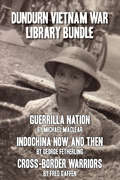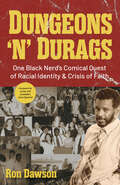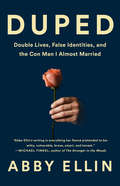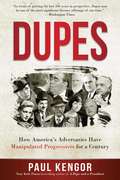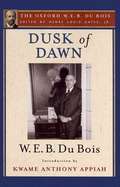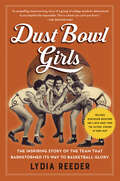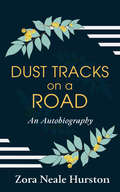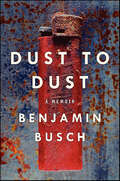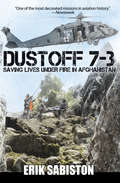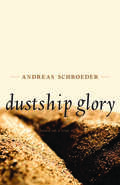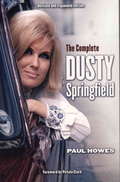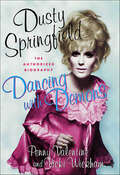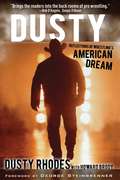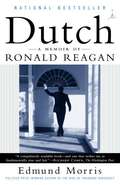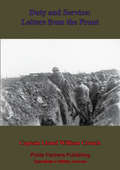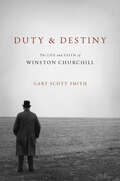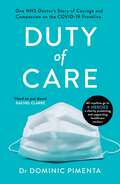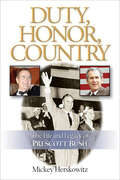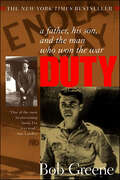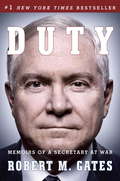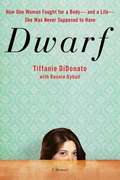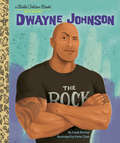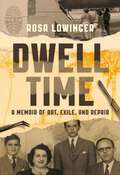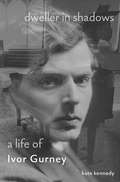- Table View
- List View
Dundurn Vietnam War Library Bundle: Guerrilla Nation / Indochina Now and Then / Cross-Border Warriors
by George Fetherling Michael Maclear Fred GaffenThe Vietnam War was a regional conflict that turned into an epic confrontation between ideologies, leaving deep scars on the psyches of nations that fought and long-lasting physical damage to Vietnam itself. The three books in this bundle cover different aspects of the war and the region, from Michael Maclear’s personal memories as an embedded journalist in North Vietnam to George Fetherling’s observations of the state of Southeast Asia today to military historian Fred Gaffen’s analysis of the experiences of soldiers travelling to faraway lands to fight in their countries’ wars. Includes Cross-Border Warriors Guerrilla Nation Indochina Now and Then
Dungeons 'n' Durags: One Black Nerd's Comical Quest of Racial Identity & Crisis of Faith
by Ron DawsonFunny Stories About White Privilege and Black Identity from a Black Nerd’s PerspectiveAuthor and Ebony Magazine podcaster Ron Dawson lends his wit and comical social commentary to tell the story of how one of the “whitest” and nerdiest of black men finally woke up, found his blackness, and lost all inhibitions at dropping the f-bomb.A coming-of-age story of black identity. In the suburbs of Atlanta, Ron was a black nerd (aka “blerd”) living very comfortably in his white world. He loved his white wife, worked well with his white workmates, and worshiped at a white church. On November 8, 2016, everything changed when Trump became POTUS. Ron began a journey of self-discovery that made him question everything —from faith to friendships.Part social commentary and part fantastical narrative. This book goes where no blerd has gone before. In a psychedelic way, Ron is guided by a guardian “angel” in the guise of Samuel L. Jackson’s character from Pulp Fiction. Sam is there to help Ron, well, be more black. Ron confronts his black “sins” and wrestles with black identity, systemic racism, and what it means to be “black” in America. Uncomfortable conversations. Throughout this book, you’ll learn lessons from a man who deconstructs his faith and confronts personal demons of racial identity. Gain new perspectives through these funny stories that will reshape your current views on black identity.Inside, you’ll find:The funniest social commentary on white privilege and black identityPolitical satire wrapped in funny stories of a man’s journey to confront the systemic racism and Christian hypocrisy around himComical if not uncomfortable conversations about what it means to be black in AmericaIf you liked You'll Never Believe What Happened to Lacey, Things That Make White People Uncomfortable, Uncomfortable Conversations with a Black Man, or I’m Judging You, you’ll love Dungeons ‘n’ Durags.
Duped: Double Lives, False Identities, and the Con Man I Almost Married
by Abby EllinAbby Ellin was shocked to learn that her fiancé was leading a secret life. But as she soon discovered, the world is full of people who aren't what they seem. <P><P>From Abby Ellin's first date with the Commander, she was caught up in a whirlwind. Within six months he'd proposed, and they'd moved in together. But soon, his exotic stories of international espionage began to unravel. Finally, it all became clear: he was lying about who he was. <P><P>After leaving him and sharing her story, she was floored to find out that her experience was far from unique. People everywhere, many of them otherwise sharp-witted and self-aware, are being deceived by their loved ones every day. <P><P>In Duped, Abby Ellin studies the art and science of lying, talks to people who've had their worlds upended by duplicitous partners, and writes with great openness about her own mistakes. These remarkable stories reveal how often we encounter people whose lives beneath the surface are more improbable than we ever imagined.
Dupes: How America's Adversaries Have Manipulated Progressives for a Century
by Paul KengorIn this startling, intensively researched book, bestselling historian Paul Kengor shines light on a deeply troubling aspect of American history: the prominent role of the "dupe." From the Bolshevik Revolution through the Cold War and right up to the present, many progressives have unwittingly aided some of America's most dangerous opponents. Based on never-before-published FBI files, Soviet archives, and other primary sources, Dupes exposes the legions of liberals who have furthered the objectives of America's adversaries. Kengor shows not only how such dupes contributed to history's most destructive ideology—Communism, which claimed at least 100 million lives—but also why they are so relevant to today's politics.
Dusk Of Dawn (The Oxford W. E. B. Du Bois)
by Kwame Anthony Appiah W. E. B. Du Bois Henry Louis GatesW. E. B. Du Bois was a public intellectual, sociologist, and activist on behalf of the African American community. He profoundly shaped black political culture in the United States through his founding role in the NAACP, as well as internationally through the Pan-African movement. Du Bois's sociological and historical research on African-American communities and culture broke ground in many areas, including the history of the post-Civil War Reconstruction period. Du Bois was also a prolific author of novels, autobiographical accounts, innumerable editorials and journalistic pieces, and several works of history. Dusk of Dawn, published in 1940, is an explosive autobiography of the foremost African American scholar of his time. Du Bois writes movingly of his own life, using personal experience to elucidate the systemic problem of race. He reflects on his childhood, his education, and his intellectual life, including the formation of the NAACP. Though his views eventually got him expelled from the association, Du Bois continues to develop his thoughts on separate black economic and social institutions in Dusk of Dawn. Readers will find energetic essays within these pages, including insight into his developing Pan-African consciousness. With a series introduction by editor Henry Louis Gates, Jr., and an introduction by Kwame Anthony Appiah, this edition is essential for anyone interested in African American history.
Dust Bowl Girls: The Inspiring Story of the Team That Barnstormed Its Way to Basketball Glory
by Lydia Reeder“A thrilling, cinematic story. I loved every minute I spent with these bold, daring women whose remarkable journey is the stuff of American legend.” —Karen Abbott, New York Times bestselling author of Liar, Temptress, Soldier, Spy The Boys in the Boat meets A League of Their Own in this true story of a Depression-era championship women’s team. In the early 1930s, during the worst drought and financial depression in American history, Sam Babb began to dream. Like so many others, this charismatic Midwestern basketball coach wanted a reason to have hope. Traveling from farm to farm near the tiny Oklahoma college where he coached, Babb recruited talented, hardworking young women and offered them a chance at a better life: a free college education in exchange for playing on his basketball team, the Cardinals. Despite their fears of leaving home and the sacrifices that their families would face, the women joined the team. And as Babb coached the Cardinals, something extraordinary happened. These remarkable athletes found a passion for the game and a heartfelt loyalty to one another and their coach--and they began to win. Combining exhilarating sports writing and exceptional storytelling, Dust Bowl Girls takes readers on the Cardinals’ intense, improbable journey all the way to an epic showdown with the prevailing national champions, helmed by the legendary Babe Didrikson. Lydia Reeder captures a moment in history when female athletes faced intense scrutiny from influential figures in politics, education, and medicine who denounced women’s sports as unhealthy and unladylike. At a time when a struggling nation was hungry for inspiration, this unlikely group of trailblazers achieved much more than a championship season.
Dust Tracks on a Road: An Autobiography (Perennial Bestsellers Series)
by Zora Neale HurstonA candid, funny, bold and poignant autobiography from one of literature's most cherished voices. Dust Tracks on a Road is the enthralling account of Zora Neale Hurston's rise from an impoverished childhood in the rural South to celebrated artist of the Harlem Renaissance. Penguin Random House Canada is proud to bring you classic works of literature in e-book form, with the highest quality production values. Find more today and rediscover books you never knew you loved.
Dust to Dust: A Memoir
by Benjamin Busch“A wonderful book, original in concept and stunningly written.”—Ward Just“Elegiac, funny, wistful, deep, and wonderfully human, Dust to Dust moved me to laughter and tears, sometimes simultaneously.”—Karl Marlantes, bestselling author of Matterhorn and What It Is Like to Go to WarTim O’Brien meets Annie Dillard in this remarkable memoir by debut author Benjamin Busch. Much more than a war memoir, Dust to Dust brilliantly explores the passage through a lifetime—a moving meditation on life and death, the adventures of childhood and revelations of adulthood. Seemingly ordinary things take on a breathtaking radiance when examined by this decorated Marine officer—veteran of two combat tours in Iraq—actor on the hit HBO series The Wire, and son of acclaimed novelist Frederick Busch. Above all, Benjamin Busch is a truly extraordinary new literary talent as evidenced by his exemplary debut, Dust to Dust—an original, emotionally powerful, and surprisingly refreshing take on an American soldier’s story.
Dustoff 7-3: Saving Lives Under Fire in Afghanistan
by Erik SabistonDustoff 7-3 tells the true story of four unlikely heroes in the rugged mountains of Afghanistan, where medics are forced to descend on wires to reach the wounded and helicopter pilots must fight wind, weather, and enemy fire to pluck casualties from some of the world's most difficult combat arenas. Complete opposites thrown together, cut off, and outnumbered, Chief Warrant Officer Erik Sabiston and his flight crew answered the call in a race against time, not to take lives--but to save them. The concept of evacuating wounded soldiers by helicopter developed in the Korean War and became a staple during the war in Vietnam where heroic, unarmed chopper crews flew vital missions known to the grateful grunts on the ground as Dustoffs. The crew of Dustoff 7-3 carried on that heroic tradition, flying over a region that had seen scores of American casualties, known among veterans as the Valley of Death. At the end of Operation Hammer Down, they had rescued 14 soldiers, made three critical supply runs, recovered two soldiers killed in action, and nearly died. It took all of three days.
Dustship Glory
by Don Kerr Andreas SchroederIn this new edition of a prairie classic, Andreas Schroeder fictionalizes the true story of Tom Sukanen's wild scheme to build an ocean-going ship in the middle of a wheat field in Saskatchewan. Set during the hardships of the "Dirty Thirties," Dustship Glory presents us with Sukanen's mythic effort to escape both the drought and pestilence of his time, as well as his own personal struggle to be free. Featuring an illuminating foreword by beloved Saskatoon writer Don Kerr, Dustship Glory will provide Canadian and international audiences alike with the opportunity to reacquaint themselves with the dramatic tale of a ship that still stands in the fields south of Moose Jaw in Saskatchewan.
Dusty Springfield
by Paul HowesWhen shy convent girl Mary O'Brien reinvented herself as Dusty Springfield, one of the most glamorous, accomplished, and acclaimed pop divas of the 1960s was born. Drawing on meticulous archive research and interviews with Dusty's friends and collaborators, this comprehensive reference addresses the entire arc of Dusty's career in details, and includes more than 70 pictures of Dusty live and in the studio. This revised edition includes new chapters on the Lana Sisters and the Springfields, expanded entries on Dusty's solo tracks, and an in-depth analysis of Dusty's live work for TV and radio.
Dusty Springfield: The Authorized Biography
by Penny Valentine Vicki WickhamDusty Springfield led a tragic yet inspiring life, battling her way to the top of the charts and into the hearts of music fans world-wide. Her signature voice made songs such as "I Only Want to Be with You," "Son of a Preacher Man," and "You Don't Have to Say You Love Me," international hits. In Dancing with Demons, two of her closest friends, Valentine and Wickham, capture, with vivid memories and personal anecdotes, a Dusty most people never glimpsed in this no-holds-barred yet touching portrait of one of the world's true grand dames of popular music.
Dusty: Reflections of Wrestling's American Dream
by Howard Brody George Steinbrenner Dusty RhodesFor over two decades of pro wrestling, Dusty "the American Dream" Rhodes dominated the ring. Known for his jaw-dropping antics and bone-crunching skills, Rhodes became one of wrestling's first superstars. In this riveting narrative, Rhodes chronicles his journey through an industry plagued with political infighting, greedy promoters, destructive personalities, multi-millionaires, and great leaders.
Dutch: A Memoir of Ronald Reagan
by Edmund MorrisThis monumental work offers the most insightful and elegant portrait to date of Ronald Reagan. The biography written with complete interpretive freedom is as revolutionary in method as it is formidable in scholarship. Thirteen years of exhaustive research in the archives of Washington and Hollywood, and thousands of hours of interviews with the President and his family, friends, allies, and enemies, equipped Morris with an unmatched knowledge of one of the twentieth century's greatest leaders.
Duty And Service: Letters From The Front.
by Captain Lionel William CrouchCaptain Crouch had served in the Territorial Army for some years before the cataclysmic struggle in Europe began in 1914. Unlike all the other belligerent parties, Britain did not, and still does not, have standing military conscription; the Regular Army of full-time highly trained volunteers provide the first line soldiers. Bolstering the first line soldiers were the part-time volunteers of the Territorial Army, providing additional manpower and more limited service. However, during both World Wars the men of the Territorial Army were in dire necessity of the time pressed forward into the line as fighting divisions, the men eager to bring the fight to the enemy.Our Author's war time service in the Oxford and Buckinghamshire Light Infantry started the moment that war broke out, from August 1914 to March 1915; he and his men trained to reach a peak of efficiency. This moment could not come too soon: the first seven divisions of the Regular Army that had formed the initial expeditionary forces had ceased to exist in the face of overwhelming number of the enemy. The Territorials and other Reserve forces from all over the British empire rushed to France and were plunged into the thick of the fighting amongst the trenches.Captain Crouch's letters form an unbroken stream between the mobilization, and are in equal part illuminating and evocative of the life of a young man who fell in service to his country. Although place-names were omitted from his letters due to censorship of the time , he was interred at Pozières British Cemetery, Ovillers-La Boisselle, meaning that he probably fell in this area during the battle of the Somme.An engaging read.Author -- Captain Lionel William Crouch (1886-1916)Text taken, whole and complete, from the edition published for private circulation 1917.Original Page Count - 158 pages.
Duty and Destiny: The Life and Faith of Winston Churchill (Library of Religious Biography (LRB))
by Gary Scott SmithA nuanced portrait of a great historical figure considered everything from a &“God-haunted man&” to a &“stalwart nonbeliever&” What did faith mean to Winston Churchill? Churchill was far from transparent about his religious beliefs and never regularly attended church services as an adult, even considering himself &“not a pillar of the church but a buttress,&” in the sense that he supported it &“from the outside.&” But Gary Scott Smith assembles pieces of Churchill&’s life and words to convey the profound sense of duty and destiny, partly inspired by his religious convictions, that undergirded his outlook. Reflecting on becoming prime minister in 1940, he wrote, &“It felt as if I were walking with destiny, and that all my past life had been but a preparation for this hour and for this trial.&” In a similarly grand fashion, he described opposing the Nazis—and later the Soviets—as a struggle between light and darkness, driven by the duty to preserve &“humane, enlightened, Christian society.&” Though Churchill harbored intellectual doubts about Christianity throughout his life, he nevertheless valued it greatly and drew on its resources, especially in the crucible of war. In Duty and Destiny, Smith unpacks Churchill&’s paradoxical religious views and carefully analyzes the complexities of his legacy. This thorough examination of Churchill&’s religious life provides a new narrative structure to make sense of one of the most important figures of the twentieth century.
Duty of Care: 'This is the book everyone should read about COVID-19' Kate Mosse
by Dominic Pimenta'Beautifully written, passionate and moving, this is the book everyone should read about COVID-19' Kate Mosse'Hard to put down' Rachel Clarke'Gripping, humane, eye-opening and seriously tense' Ian DuntThe first book to tell the full story of the COVID-19 pandemic from a doctor on the frontline.ALL ROYALTIES FROM SALES GO TO HEROES, A CHARITY PROTECTING AND SUPPORTING HEALTHCARE WORKERS. On the 8th of February, Dr Dominic Pimenta encountered his first suspected case of coronavirus. Within a week, he began wearing a mask on the tube, and within a month, he moved over to the Intensive Care Unit to help fight the virus.From the initial whispers coming out of China and the collective hesitation to class this as a pandemic to full lockdown and the continued battle to treat whoever came through the doors, Dr Pimenta tells the heroic stories of how the entire system shifted to tackle this outbreak and how, ultimately, the staff managed to save lives.This incredible account captures the shock and surprise, the panic and power of an unprecedented time, and how, at this moment of despair, human generosity and kindness prevailed.'A startlingly personal account ... It can be described as a memoir, a thriller or a horror story, but it is really all at once' Observer'Reads like a thriller – a first-hand account of a group of individuals facing a terrible adversary – but it also moved me sometimes to tears because it communicates the humanity of the patients, as well as the NHS staff. As with all great writing, its honesty shines out' Tim Walker'An excellent book ... Moving and fascinating in equal measure' Xand van Tulleken
Duty, Honor, Country: The Life and Legacy of Prescott Bush
by Mickey HerskowitzA profile of the Bush political clan patriarch—who he was and what he stood for, the examples he set, the events he shared, and the lives he touched.Prescott Bush is the only person in US history to be father of a US President, grandfather of a US President, and grandfather of a state governor. Duty, Honor, Country is more than a biography of the U.S. Senator from Connecticut, although it is that. It looks at the principles that Prescott Bush passed on like family heirlooms to his five children, including George H.W. Bush, the forty-first President of the United States: discipline, duty, ethics, commitment, courage, honor, honesty, loyalty, and responsibility. And it looks at the ways the Bush family legacy has made Prescott Bush, former President George Bush, George W. Bush, and Jeb Bush give themselves to public service. “My father believed in the concept of noblesse oblige,” said former President George Bush. “You made your money and you had a duty to serve the community or your country.”Written with the encouragement and enthusiasm of former President Bush, the book is a readable story of noblesse oblige in action, from the time Prescott Bush served in town government in Greenwich, Connecticut, to his career as a US Senator from Connecticut, to his role in passing far-reaching legislation in the Eisenhower years. It also deals honestly with Prescott Bush’s alleged business relationships with Nazi industrialists and other accusations. Half of the book also shows how the commitment to public service was lived out in the lives of Prescott’s children and grandchildren, focusing on his son George H.W. Bush and his grandsons George W. Bush and Jeb Bush.
Duty: A Father, His Son, and the Man Who Won the War
by Bob GreeneWhen Bob Greene went home to central Ohio to be with his dying father, it set off a chain of events that led him to knowing his dad in a way he never had before—thanks to a quiet man who lived just a few miles away, a man who had changed the history of the world.Greene's father—a soldier with an infantry division in World War II—often spoke of seeing the man around town. All but anonymous even in his own city, carefully maintaining his privacy, this man, Greene's father would point out to him, had "won the war." He was Paul Tibbets. At the age of twenty-nine, at the request of his country, Tibbets assembled a secret team of 1,800 American soldiers to carry out the single most violent act in the history of mankind. In 1945 Tibbets piloted a plane—which he called Enola Gay, after his mother—to the Japanese city of Hiroshima, where he dropped the atomic bomb.On the morning after the last meal he ever ate with his father, Greene went to meet Tibbets. What developed was an unlikely friendship that allowed Greene to discover things about his father, and his father's generation of soldiers, that he never fully understood before. Duty is the story of three lives connected by history, proximity, and blood; indeed, it is many stories, intimate and achingly personal as well as deeply historic. In one soldier's memory of a mission that transformed the world—and in a son's last attempt to grasp his father's ingrained sense of honor and duty—lies a powerful tribute to the ordinary heroes of an extraordinary time in American life.What Greene came away with is found history and found poetry—a profoundly moving work that offers a vividly new perspective on responsibility, empathy, and love. It is an exploration of and response to the concept of duty as it once was and always should be: quiet and from the heart. On every page you can hear the whisper of a generation and its children bidding each other farewell.
Duty: Memoirs of a Secretary at War
by Robert M GatesFrom the former secretary of defense, a strikingly candid, vivid account of serving Presidents George W. Bush and Barack Obama during the wars in Iraq and Afghanistan. When Robert M. Gates received a call from the White House, he thought he'd long left Washington politics behind: After working for six presidents in both the CIA and the National Security Council, he was happily serving as president of Texas A&M University. But when he was asked to help a nation mired in two wars and to aid the troops doing the fighting, he answered what he felt was the call of duty.
Dwarf: A Memoir
by Rennie Dyball Tiffanie DidonatoTiffanie DiDonato was born with dwarfism. Her limbs were extremely short preventing her from even reaching her own ears. To achieve independence, she underwent a series of painful bone-lengthening surgeries that gave her an unprecedented 14 inches of height--and the independence she never thought she'd have. After her surgeries, Tiffanie was able to learn to drive, to live in the dorms during college, and to lead a normal life. As a volunteer during the War in Iraq, she wrote to the men stationed abroad. Specifically, she became a pen pal to one of the Marines, and because of this relationship, he ultimately became her husband. In this book, she wrote: "It's okay with me if you picked up this book because you're curious about what it's like to live with dwarfism. But I hope that you'll take away much more--about freedom, finding independence, and adapting to the world when it won't adapt to you."
Dwarf: A Memoir
by Rennie Dyball Tiffanie Didonato"It's okay with me if you picked up this book because you're curious about what it's like to live with dwarfism. But I hope that you'll take away much more-about adapting to the world when it won't adapt to you. ”-from Dwarf A memoir of grit and transformation for anyone who has been told something was impossible and then went on to do it anyway. Tiffanie DiDonato was born with dwarfism. Her limbs were so short that she was not able to reach her own ears. She was also born with a serious case of optimism. She decided to undergo a series of painful bone-lengthening surgeries that gave her an unprecedented 14 inches of height-and the independence she never thought she’d have. After her surgeries, Tiffanie was able to learn to drive, to live in the dorms during college, and to lead a normal life. She even made time to volunteer, writing to troops stationed abroad, and one of those Marine pen pals ultimately became her husband. Dwarf is a moving and, at times, funny testament to the power of sheer determination, and has been compared to Andrew solomon's Far From the Tree. .
Dwayne Johnson: A Little Golden Book Biography (Little Golden Book)
by Frank BerriosHelp your little one dream big with a Little Golden Book biography about superstar Dwayne "The Rock" Johnson! It's the perfect introduction to nonfiction for preschoolers.This Little Golden Book about Dwayne "The Rock" Johnson—wrestling star, movie star, TV star, and all-around nice guy—is an inspiring read-aloud. Young children will learn that even superstars have setbacks: when Dwayne's dream of playing in the NFL didn't come true, he had to find a different path to happiness and success.Look for more Little Golden Book biographies: • Betty White • Carol Burnett • Lucille Ball • Harry Belafonte • Julie Andrews
Dwell Time: A Memoir of Art, Exile, and Repair
by Rosa LowingerWhat Kirkus describes as a "masterful revelation about life and art imitating each other in maintenance and repair" in a starred review, Dwell Time is an illuminating debut memoir by one of the few prominent Latinas in the field of art and architectural conservation; a moving portrait of a Cuban Jewish family&’s intergenerational trauma; and a story about repair and healing that will forever change how you see the objects and places we cherish and how we manage damage and loss.Dwell Time is a term that measures the amount of time something takes to happen – immigrants waiting at a border, human eyes on a website, the minutes people wait in an airport, and, in art conservation, the time it takes for a chemical to react with a material.Renowned art conservator Rosa Lowinger spent a difficult childhood in Miami among people whose losses in the Cuban revolution, and earlier by the decimation of family in the Holocaust, clouded all family life.After moving away to escape the &“cloying exile&’s nostalgia,&” Lowinger discovered the unique field of art conservation, which led her to work in Tel Aviv, Philadelphia, Rome, Los Angeles, Honolulu, Charleston, Marfa, South Dakota, and Port-Au-Prince. Eventually returning to Havana for work, Lowinger suddenly finds herself embarking on a remarkable journey of family repair that begins, as it does in conservation, with an understanding of the origins of damage.Inspired by and structured similarly to Primo Levi&’s The Periodic Table, this first memoir by a working art conservator is organized by chapters based on the materials Lowinger handles in her thriving private practice – Marble, Limestone, Bronze, Ceramics, Concrete, Silver, Wood, Mosaic, Paint, Aluminum, Terrazzo, Steel, Glass and Plastics. Lowinger offers insider accounts of conservation that form the backbone of her immigrant family&’s story of healing that beautifully juxtaposes repair of the material with repair of the personal. Through Lowinger&’s relentless clear-eyed efforts to be the best practitioner possible while squarely facing her fraught personal and work relationships, she comes to terms with her identity as Cuban and Jewish, American and Latinx.Dwell Time is an immigrant&’s story seen through an entirely new lens, that which connects the material to the personal and helps us see what is possible when one opens one&’s heart to another person&’s wounds.From the book: &“How, I wondered, was it possible that no one in my family had ever told me that Havana, the place where we were from, was so closely aligned to my work? More importantly, how had I managed to reencounter this ornately decorated, sagging city at the precise moment when I was beginning to see a link between restoration of the material world and personal healing?&”
Dweller in Shadows: A Life of Ivor Gurney
by Kate KennedyThe first comprehensive biography of an extraordinary English poet and composer whose life was haunted by fighting in the First World War and, later, confinement in a mental asylumIvor Gurney (1890–1937) wrote some of the most anthologized poems of the First World War and composed some of the greatest works in the English song repertoire, such as “Sleep.” Yet his life was shadowed by the trauma of the war and mental illness, and he spent his last fifteen years confined to a mental asylum. In Dweller in Shadows, Kate Kennedy presents the first comprehensive biography of this extraordinary and misunderstood artist.A promising student at the Royal College of Music, Gurney enlisted as a private with the Gloucestershire regiment in 1915 and spent two years in the trenches of the Western Front. Wounded in the arm and subsequently gassed during the Battle of Passchendaele, Gurney was recovering in hospital when his first collection of poems, Severn and Somme, was published. Despite episodes of depression, he resumed his music studies after the war until he was committed to an asylum in 1922. At times believing he was Shakespeare and that the “machines under the floor” were torturing him, he nevertheless continued to write and compose, leaving behind a vast body of unpublished work when he died of tuberculosis. Drawing on extensive archival research and spanning literary criticism, history, psychiatry and musicology, this compelling narrative sets Gurney’s life and work against the backdrop of the war and his institutionalisation, probing the links between madness, suffering and creativity.Facing death in the trenches, Gurney hoped that history might not “forget me quite.” This definitive account of his life and work helps ensure that he will indeed be remembered.
